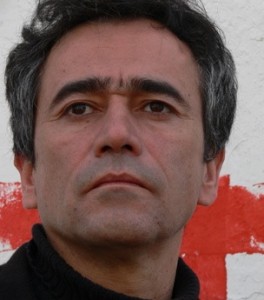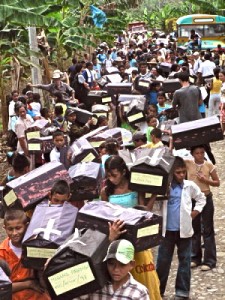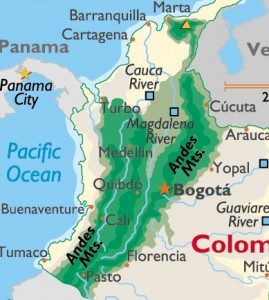“One of these days I am going to forget myself, I shall leave [myself] forgotten in some corner of the house, forget to take myself out for a walk…There are fewer and fewer people in the town, and with reason, anything could happen, everything could happen, and whatever happens there will be war, screams will echo, powder will explode.”
Within the two hu ndred fifteen pages of this short, allegorical novel, Evelio Rosero creates a microcosm of Colombian rural life in the fictional community of San Jose, where no one knows who will attack them next—the army, the paramilitaries, the guerrillas, or the drug lords. Though the residents are peaceful small farmers and businessmen with few, if any, ties to the “outside” world and virtually no interest in the country’s politics, every militant faction vying for power in Colombia somehow believes that these residents constitute an imminent threat. They convince themselves that specific San Jose residents must certainly be allied with their enemies, since their “enemies” are whoever have not declared allegiance to their own vague goals. The four militant groups each want to dominate and control the area simply to prevent any other group from controlling it, and they are willing to massacre innocent men, women, and even babies to achieve their bloody but elusive goals.
ndred fifteen pages of this short, allegorical novel, Evelio Rosero creates a microcosm of Colombian rural life in the fictional community of San Jose, where no one knows who will attack them next—the army, the paramilitaries, the guerrillas, or the drug lords. Though the residents are peaceful small farmers and businessmen with few, if any, ties to the “outside” world and virtually no interest in the country’s politics, every militant faction vying for power in Colombia somehow believes that these residents constitute an imminent threat. They convince themselves that specific San Jose residents must certainly be allied with their enemies, since their “enemies” are whoever have not declared allegiance to their own vague goals. The four militant groups each want to dominate and control the area simply to prevent any other group from controlling it, and they are willing to massacre innocent men, women, and even babies to achieve their bloody but elusive goals.

In the hands of Colombian author Rosero, every character in the novel becomes a sort of Everyman, an ordinary person living his own life, just like the ordinary people in any other country, with similar kinds of goals, a similar desire for love and family, and a similar belief (or non-belief) in a higher spiritual power. Because Rosero also creates intriguing, quirky personalities for his characters, they are livelier than most other generic, “Everyman” characters, and they therefore generate sympathy and understanding of their individual problems while they also represent broader, more elevated themes. As the village comes under fire from bloodthirsty enemies as undifferentiated to the residents as they are to the reader, the author’s universal themes of good vs. evil, power vs. subservience, and human kindness vs. barbarism become allegorically obvious.
Ismael Pasos, a seventy-year-old retired teacher, lives with his wife Otilia, also a teacher, on a small farm, the highlight of his life being his daily climb up the ladder to pick his oranges—and to peer over the wall of his neighbor’s house to watch the neighbor’s young wife, Geraldina, sunbathing  nude. Though Ismael likes to believe that no one notices, his own wife is humiliated by this behavior, and his neighbor, “the Brazilian,” is amused, considering him an inoffensive Peeping Tom. The scene on the ladder, however, is immediately juxtaposed against the story of how Ismael met his wife–on the same day that he saw a middle-aged man shot between the eyes by an eleven-year-old child at a bus station. This contrast of scenes sets the tone of the novel, emphasizing the contrasts between the sweetness of everyday life and the hopelessness of a political and social culture in which no one even bothers to chase the murderer.
nude. Though Ismael likes to believe that no one notices, his own wife is humiliated by this behavior, and his neighbor, “the Brazilian,” is amused, considering him an inoffensive Peeping Tom. The scene on the ladder, however, is immediately juxtaposed against the story of how Ismael met his wife–on the same day that he saw a middle-aged man shot between the eyes by an eleven-year-old child at a bus station. This contrast of scenes sets the tone of the novel, emphasizing the contrasts between the sweetness of everyday life and the hopelessness of a political and social culture in which no one even bothers to chase the murderer.
Now elderly, Ismael and Otilia are getting ready to visit Hortensia Galindo on the fourth anniversary of the disappearance of her husband, captured by some unknown militant group and now “disappeared.” Because Ismael has a lame leg, he lags behind Otilia as she walks to Hortensia’s anniversary, and, in excruciating pain, he decides to climb the mountain to see Maestro Claudino Alfaro, a well-known folk healer. Though the Maestro actually saw Hortensia’s husband being arrested, four years ago, he has no idea which group took him. Within days of Ismael’s trip up the mountain, several of Ismael’s neighbors disappear, even though one of them regularly paid protection money. Nothing is being done to find the missing, the Mayor blames the Minister of Defense for giving him only one battalion of infantry, and the police captain has not mounted a search party.
Gradually, the horror expands, taking over every aspect of life for Ismael. “The atmosphere, from one moment to the next, is unbreathable,” he notes. “A slow feeling of unease overtakes everything, not just human, but plants, the cats…the unmoving fish; it is as if one were not inside one’s house, despite being so.” As circumstances become progressively worse, with the atrocities becoming ever more brutal, Ismael becomes less lucid, less able to care for himself, less interested in continuing to live at all. The final scenes challenge the reader to see any hope for a peaceful life for these villagers, any hope for the future, any hope that beauty and kindness and love can possibly exist within such a culture.
Though some readers may become frustrated at not knowing exactly which factions are perpetrating the various acts of violence, others will find that not knowing the answers puts them into the shoes of the villagers more directly. Some may also feel that the characterization of Ismael becomes vague and hard to follow when he begins to lose his hold on reality, while others will feel it makes him even more human and damaged by events. The novel leaves many questions regarding the future of this area, but it leaves no question at all about the courage of the author to raise these issues in print while they are still continuing.
ALSO by Evelio Rosero: GOOD OFFICES
Photos, in order: The author’s photo appears on this Spanish language site: www.tusquetseditores.com
An interview in which the author discusses this novel with Maya Jaggi is here: http://www.independent.co.uk
A symbolic funeral procession (pictured here) for the one hundred fifty victims out of the one thousand residents of San Jose de Apartado is from www.wri-irg.org. Though the San Jose in the novel is fictional, the action there closely resembles what has happened in this real community.
San Jose de Apartado is located on a line southeast from Turbo, near the border with Panama. It is 25 miles from Medellin. See http://www.worldatlas.com for map of the area.
In 1997, San Jose de Apartado became the first of fifty “Peace Communities” in Colombia, and “On March 23, 1997, we declared ourselves the PEACE COMMUNITY OF SAN JOSE DE APARTADO, with the hope that the armed actors would respect us and that we would not have to abandon our lands.” Unfortunately, numerous massacres and assassinations have taken place in this Community of Peace since then, driving people out of their homes. Other Peace Communities have had better success, however. www.forcolombia.org
A report on the massacres, presented to the US Congress, is here: http://www.colombiasupport.net

